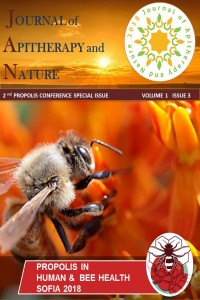Conference Paper
Year 2018,
Volume: 1 Issue: 3 - 2nd Propolis Conference Special Issue, 34 - 34, 08.12.2018
Abstract
The phenolic compounds, flavonoids in particular, are very frequent in
the plant kingdom with many beneficial properties. Some of these compounds are
present in exudates or buds of plants. They appear in propolis as a consequence
of the collection and transformation by specialized honey bees in the hive. The
aim of the study is the determination1 of phenolic compounds by
UPLC-MS/MS and UPLC-PDA in methanolic extracts2 of 134 samples of
propolis from Castilla y León (North and Centre of Spain). Such samples were
gathered using high density polyethylene mesh for food use which placed in
Langstroth beehive from April 2011 to August 2012.
The results obtained reveal the interesting source of
bioactive compounds of the North and Centre of Spain propolis, being the most
significant caffeic acid and its derivatives (CAPE and isoprenyl caffeate),
chrysin, pinobanksin, p-coumaric acid, galangin and kaempferol; other compounds
identified only in some samples were benzoic acid, trans-ferulic acid,
taxifolin, luteolin, sakuranetin, apigenin+genistein and eriodictyol.
Furthermore, the content of CAPE and isoprenyl caffeate may restrict its use,
for the food and pharmaceutical industry, since they are considered allergens3.
bioactive compounds of the North and Centre of Spain propolis, being the most
significant caffeic acid and its derivatives (CAPE and isoprenyl caffeate),
chrysin, pinobanksin, p-coumaric acid, galangin and kaempferol; other compounds
identified only in some samples were benzoic acid, trans-ferulic acid,
taxifolin, luteolin, sakuranetin, apigenin+genistein and eriodictyol.
Furthermore, the content of CAPE and isoprenyl caffeate may restrict its use,
for the food and pharmaceutical industry, since they are considered allergens3.
Keywords
References
- 1. 1 Kasote, D., Suleman, T., Chen, W., Sandasi, M., Viljoen, A., van Vuuren, S. (2014) "Chemical profiling and chemometric analysis of South African propolis", Biochemical Systematics and Ecology, 55, pp. 156-163.
- 2. Dias, L. G., Pereira, A. P., Estevinho, L. M. (2012) "Comparative study of different Portuguese samples of propolis: pollinic, sensorial, physicochemical, microbiological characterization and antibacterial activity", Food and Chemical Toxicology, 50, pp. 4246-4253.
- 3. Walgrave, S. E., Warshaw, E. M., Glesne, L. A. (2005) "Allergic contact dermatitis from propolis", Dermatitis, 16(4), pp. 209-215.
Year 2018,
Volume: 1 Issue: 3 - 2nd Propolis Conference Special Issue, 34 - 34, 08.12.2018
Abstract
References
- 1. 1 Kasote, D., Suleman, T., Chen, W., Sandasi, M., Viljoen, A., van Vuuren, S. (2014) "Chemical profiling and chemometric analysis of South African propolis", Biochemical Systematics and Ecology, 55, pp. 156-163.
- 2. Dias, L. G., Pereira, A. P., Estevinho, L. M. (2012) "Comparative study of different Portuguese samples of propolis: pollinic, sensorial, physicochemical, microbiological characterization and antibacterial activity", Food and Chemical Toxicology, 50, pp. 4246-4253.
- 3. Walgrave, S. E., Warshaw, E. M., Glesne, L. A. (2005) "Allergic contact dermatitis from propolis", Dermatitis, 16(4), pp. 209-215.
There are 3 citations in total.
Details
| Primary Language | English |
|---|---|
| Journal Section | 2nd Propolis Conference Special Issue |
| Authors | |
| Publication Date | December 8, 2018 |
| Published in Issue | Year 2018 Volume: 1 Issue: 3 - 2nd Propolis Conference Special Issue |
Cite
- Google Akademik (Google Scholar)
- idealonline
- Directory of Research Journal Indexing (DRJI)
- Asos İndeks

